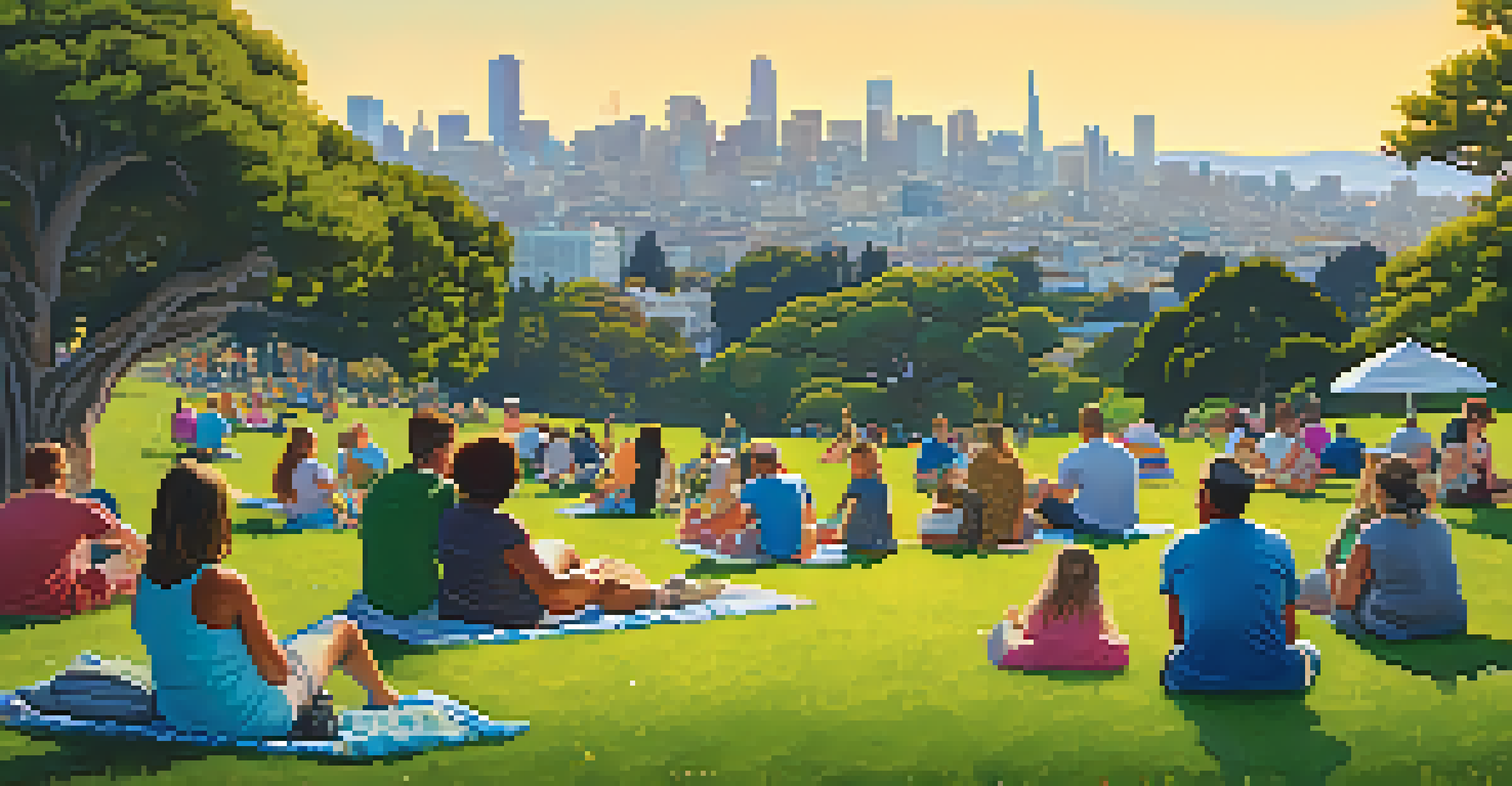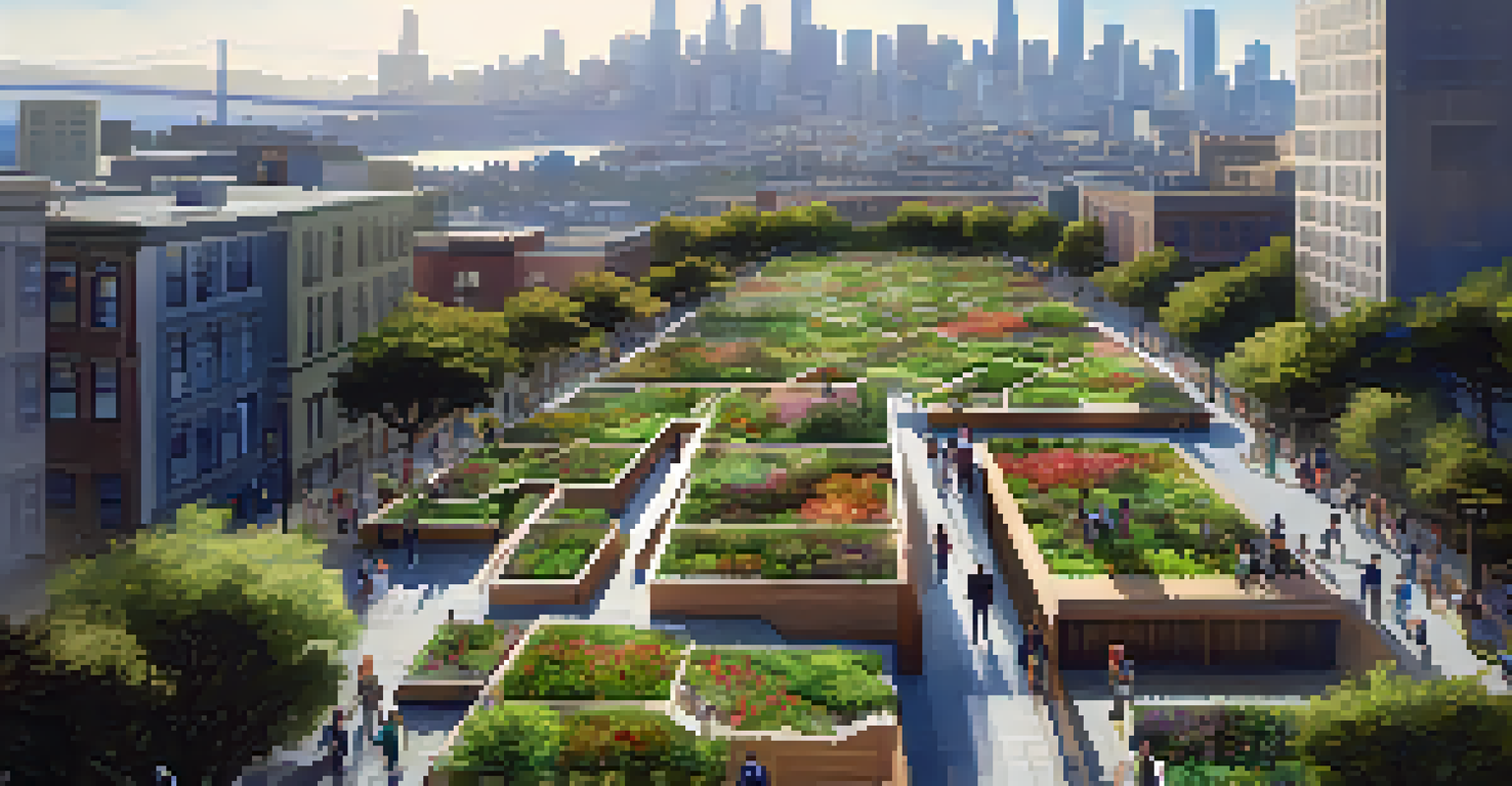Green Spaces and Parks: Urban Planning in San Francisco

The Importance of Green Spaces in Urban Areas
Green spaces play a crucial role in enhancing the quality of life in urban settings. They provide a natural retreat, helping to reduce stress and improve mental well-being. In cities like San Francisco, parks and gardens are not just recreational areas, but vital ecosystems that support biodiversity and wildlife.
The parks are the lungs of the city.
These green spaces also serve as community hubs, where people from diverse backgrounds can come together. They encourage social interaction, promote physical activity, and create a sense of belonging. Moreover, they can significantly increase property values, making neighborhoods more desirable.
Incorporating green spaces into urban planning is essential for promoting sustainability. They help manage stormwater, reduce urban heat, and improve air quality, making cities more resilient to climate change. For San Francisco, this integration is not just beneficial; it's necessary for a healthier urban environment.
San Francisco's Parks: A Brief Overview
San Francisco is home to a variety of parks that cater to different interests and needs. Golden Gate Park, one of the largest urban parks in the U.S., spans over 1,000 acres and offers everything from gardens to museums. Its lush landscapes and recreational facilities make it a beloved spot for locals and tourists alike.

Another gem is Dolores Park, known for its vibrant community atmosphere and stunning views of the city skyline. This park is a prime example of how urban green spaces can foster community spirit. Events, picnics, and gatherings frequently take place here, contributing to its lively ambiance.
Green Spaces Enhance Urban Life
Green spaces in cities like San Francisco improve mental well-being, promote community interaction, and support biodiversity.
Smaller parks, such as Alamo Square and Washington Square, also play a significant role in the urban fabric. They provide essential green relief amidst the hustle and bustle of city life, allowing residents to recharge and enjoy the outdoors. Each park reflects the city's unique character and history, enriching the urban experience.
Urban Planning: Integrating Green Spaces
Integrating green spaces into urban planning requires careful thought and collaboration. Urban planners and city officials must consider the needs of the community, balancing development with the preservation of nature. This involves engaging with residents to understand their desires and incorporating their feedback into planning processes.
Green spaces serve as a vital part of our urban ecosystem, fostering community and enhancing the quality of life.
In San Francisco, the city has implemented various initiatives to enhance its green spaces. This includes developing new parks in underserved areas and revitalizing existing ones to ensure they meet community needs. The goal is to create accessible, inclusive spaces that everyone can enjoy.
Moreover, innovative designs like green roofs and vertical gardens are becoming more common in urban planning. These features not only beautify the landscape but also contribute to environmental sustainability. By thoughtfully integrating green spaces, San Francisco aims to create a more livable city for current and future residents.
Community Engagement in Park Development
Community engagement is vital in the development of parks and green spaces. Residents often have the best insights into what their neighborhoods need, making their input invaluable. San Francisco has witnessed numerous successful projects that arose from community-driven initiatives.
For example, the transformation of the former Potrero Hill public housing site into a vibrant park was largely influenced by local residents. Their desires for playgrounds, gardens, and open spaces shaped the final design, ensuring it met the community's needs. This participatory approach fosters a sense of ownership and pride among residents.
Community Engagement is Key
Involving residents in park development fosters a sense of ownership and ensures that green spaces meet local needs.
Involving the community not only enhances the design process but also encourages people to utilize and care for these spaces. When residents feel connected to their parks, they are more likely to participate in maintenance and community events, creating a stronger bond within the neighborhood.
Challenges in Maintaining Urban Green Spaces
While green spaces are essential, maintaining them in urban settings presents unique challenges. Budget constraints often limit the resources available for upkeep, leading to overgrown areas and neglected facilities. In a city like San Francisco, where real estate is at a premium, finding funds for maintenance can be particularly difficult.
Additionally, the high foot traffic in popular parks can lead to wear and tear. This can result in damaged landscapes, litter, and even safety concerns. It's crucial for city planners and park officials to implement sustainable maintenance strategies that ensure parks remain clean and safe for all users.
Community involvement can also play a role in overcoming these challenges. By organizing volunteer days and clean-up events, residents can help maintain their beloved green spaces. This not only alleviates some of the burden on city resources but also strengthens community ties and fosters a collective responsibility for local parks.
The Role of Technology in Urban Green Spaces
Technology is increasingly playing a role in the management and enhancement of urban green spaces. From smart irrigation systems that conserve water to apps that provide park information, tech innovations are making parks more accessible and sustainable. In San Francisco, these tools can help monitor park usage and conditions, allowing for more efficient maintenance.
Moreover, technology can foster community engagement by providing platforms for residents to share feedback or organize events. Social media and community apps enable citizens to connect over shared interests, from organizing park clean-ups to promoting local events. This connectivity enhances the community's involvement in maintaining and enjoying these spaces.
Technology Aids Urban Park Management
Innovations like smart irrigation and community apps enhance the accessibility and sustainability of urban green spaces.
Furthermore, advancements in landscape design software allow planners to visualize and simulate park designs before implementation. This ensures that the final product aligns with community needs and environmental considerations. As technology continues to evolve, its integration into urban planning will undoubtedly shape the future of green spaces in San Francisco.
Future Directions for Green Spaces in San Francisco
Looking ahead, the future of green spaces in San Francisco appears promising, but it requires ongoing commitment and innovation. As the city continues to grow, there is a pressing need to prioritize the development of new parks and the enhancement of existing ones. This includes exploring unutilized areas and transforming them into vibrant green spaces.
Additionally, climate change poses significant challenges that urban planners must address. Future park designs will need to incorporate resilience strategies to adapt to changing weather patterns, such as drought-resistant landscaping and flood management systems. By doing so, San Francisco can ensure its parks remain functional and enjoyable for years to come.

Ultimately, the success of urban green spaces hinges on collaboration among city officials, community members, and environmental organizations. By working together, they can create a sustainable and inclusive urban landscape that not only enhances the beauty of San Francisco but also fosters a sense of connection and well-being for all its residents.